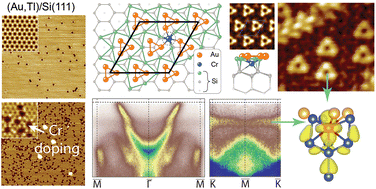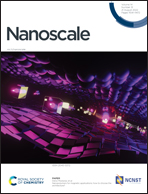Unveiling the hybridization between the Cr-impurity-mediated flat band and the Rashba-split state of the α-Au/Si(111) surface†
Abstract
Adsorption of foreign atoms onto 2D materials can either lead to ordinary electron doping or the emergence of new electronic effects including topology, superconductivity, and quantum anomalous Hall and Kondo states. We have investigated the effect of Cr doping on the electronic structure of the α-Au/Si(111)-  surface and its adsorbate-modified family. It has been found that below a critical coverage of ∼0.05 monolayer, Cr adatoms penetrate beneath the Au and topmost Si layers and induce the occupied resonance flat band in the electronic spectrum as revealed by angle-resolved photoelectron spectroscopy. Further deposition of Cr leads to the growth of the 3D islands spoiling the surface homogeneity. Using density functional theory calculations, we have disclosed the effects of Cr doping on the electronic band structure and revealed the nature of hybridization between the Cr-induced magnetic-split band and the Au-induced Rashba-split surface state. We believe that the synthesized 2D phases and electronic effects produced by magnetic atom doping in the ultimate two-dimensional limit will stimulate further investigations related to the highly correlated phases and will find practical applications in nanoelectronic devices.
surface and its adsorbate-modified family. It has been found that below a critical coverage of ∼0.05 monolayer, Cr adatoms penetrate beneath the Au and topmost Si layers and induce the occupied resonance flat band in the electronic spectrum as revealed by angle-resolved photoelectron spectroscopy. Further deposition of Cr leads to the growth of the 3D islands spoiling the surface homogeneity. Using density functional theory calculations, we have disclosed the effects of Cr doping on the electronic band structure and revealed the nature of hybridization between the Cr-induced magnetic-split band and the Au-induced Rashba-split surface state. We believe that the synthesized 2D phases and electronic effects produced by magnetic atom doping in the ultimate two-dimensional limit will stimulate further investigations related to the highly correlated phases and will find practical applications in nanoelectronic devices.



 Please wait while we load your content...
Please wait while we load your content...